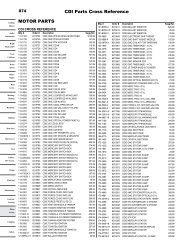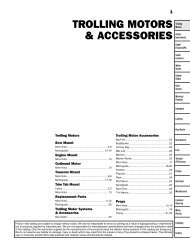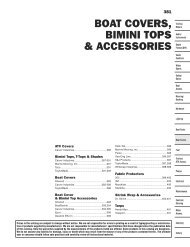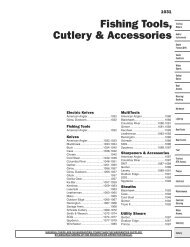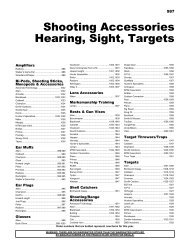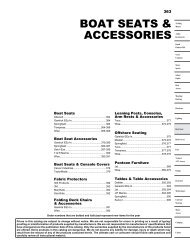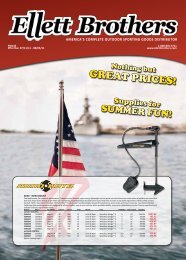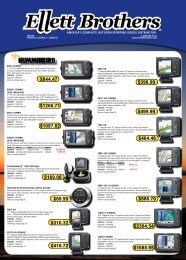pdf File - Ellett Brothers
pdf File - Ellett Brothers
pdf File - Ellett Brothers
- No tags were found...
You also want an ePaper? Increase the reach of your titles
YUMPU automatically turns print PDFs into web optimized ePapers that Google loves.
698<br />
Michigan Wheel<br />
Trolling<br />
Motors<br />
Audio/<br />
Instruments<br />
Depth<br />
Finders/GPS<br />
Vests/<br />
Cushions<br />
Water<br />
Sports<br />
Safety/<br />
Optics<br />
Boat<br />
Access.<br />
Mooring/<br />
Docking<br />
PROPELLER BASICS<br />
Finding the right match between the propeller, engine type and boat size will optimize the following performance factors:<br />
• Increased Top End Speed<br />
• Faster Planing Speed (Hole Shot)<br />
• Improved Low End Punch<br />
• Load Carrying Capability<br />
If you want to modify your boat’s performance, consider the following before making your selection:<br />
3-Blade Propeller vs. 4-Blade Propeller<br />
We recommend 3-Blade propellers for recreational boats with 3,<br />
4, and 6 cylinder outboards and I/O engines. These propellers<br />
provide good hole shot and top-speed performance.<br />
We recommend 4-Blade propellers for practical, all-around boat<br />
performance. These propellers enhance handling, hole shot, loadcarrying<br />
performance, and fuel efficiency.<br />
Hardware<br />
Lighting<br />
Boat Seats<br />
Boat Covers<br />
Advantage of a Left Hand Propeller<br />
Two propellers spinning in the same direction on twin engine<br />
boats will create steering torque. In other words, two right-hand<br />
propellers pull the stern hard to the right and the bow to the left.<br />
Two opposite-direction (counter-rotating) propellers on twin<br />
engines eliminate this steering torque because the left-hand<br />
propeller balances out the right-hand propeller. This results in<br />
better straight-line tracking and helm control at high speed.<br />
Fuel<br />
Trailers/<br />
ATV Access.<br />
Pumps<br />
Affect of Slip on Performance<br />
Slip is the difference between actual and theoretical travel<br />
of the propeller blades through water. A properly matched<br />
propeller will actually move forward about 80 to 90 percent of the<br />
theoretical pitch.<br />
Electrical<br />
Maintenance<br />
Controls/<br />
Steering<br />
Motor<br />
Access.<br />
Camping<br />
Aluminum vs. Stainless Steel<br />
Most pleasure boats are factory equipped with aluminum<br />
propellers. Aluminum propellers are relatively inexpensive, easy<br />
to repair, and under normal conditions can last for many years.<br />
Stainless steel is more expensive, but much stronger and durable<br />
than aluminum. If you are looking for better performance than<br />
can be provided by your aluminum propeller, such as ultimate<br />
top speed or better acceleration, a stainless steel propeller may<br />
be required.<br />
Theoretical<br />
Actual<br />
Cutlery<br />
A5



